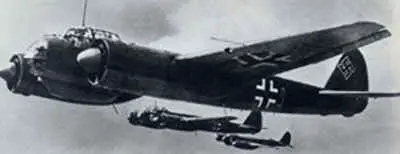The Junkers Ju 88 was a highly versatile plane that saw service throughout World War Two. The Junkers 88 remained in production right through to 1945.
 |
The first specifications came in 1935 for a high-speed bomber. The planned bomber had to be able to have a top speed of 298 mph (480 km/h).
The prototype Junkers 88 first flew in December 1936. By the third variant, a speed of 323 mph (520 km/h) had been reached. In March 1939, a Ju 88 flew for 1000 km (621 miles) carrying a 2000 kg (4,409 lb) payload at 321 mph(517 km/h) – a record.
The planes themselves entered service with the Luftwaffe in September 1939 in the blitzkrieg attack on Poland.
During the Battle of Britain, the Ju 88 was vulnerable to the much faster Spitfires and Hurricanes of Fighter Command but to a lesser extent than the Heinkel 111 as it was faster and more manoeuvrable than the larger Heinkel. The Junkers 88 could carry 4,400 lbs of bombs (2000kg); if it got to its designated target, it could do a great deal of damage.
Lessons learned in the battle, led to later variants of the Ju 88 having more armoured protection for the crew and more powerful weaponry. Later variants of the Ju 88 included night patrol planes that flew over British bomber bases. A fighter version was built but with little success and a night fighter was produced. The night fighter version was to have success against the planes of Bomber Command. Between January and March 1944, 343 RAF bombers were destroyed – a large number by night fighting Ju 88’s.
One of the main features of the Ju 88, was that it could take a large amount of damage and continue to fly. By the end of the war, nearly 15,000 had been built in nine years.
Maximum speed: 292 mph (470 km/h) at 17,390 feet (5300 metres)
Ceiling: 26,900 feet (8200 metres)
Maximum range: 1,696 miles (2730 km)
Related Posts
- The Junkers Ju 88 was a highly versatile plane that saw service throughout World War Two. The Junkers 88 remained in production right through to…
